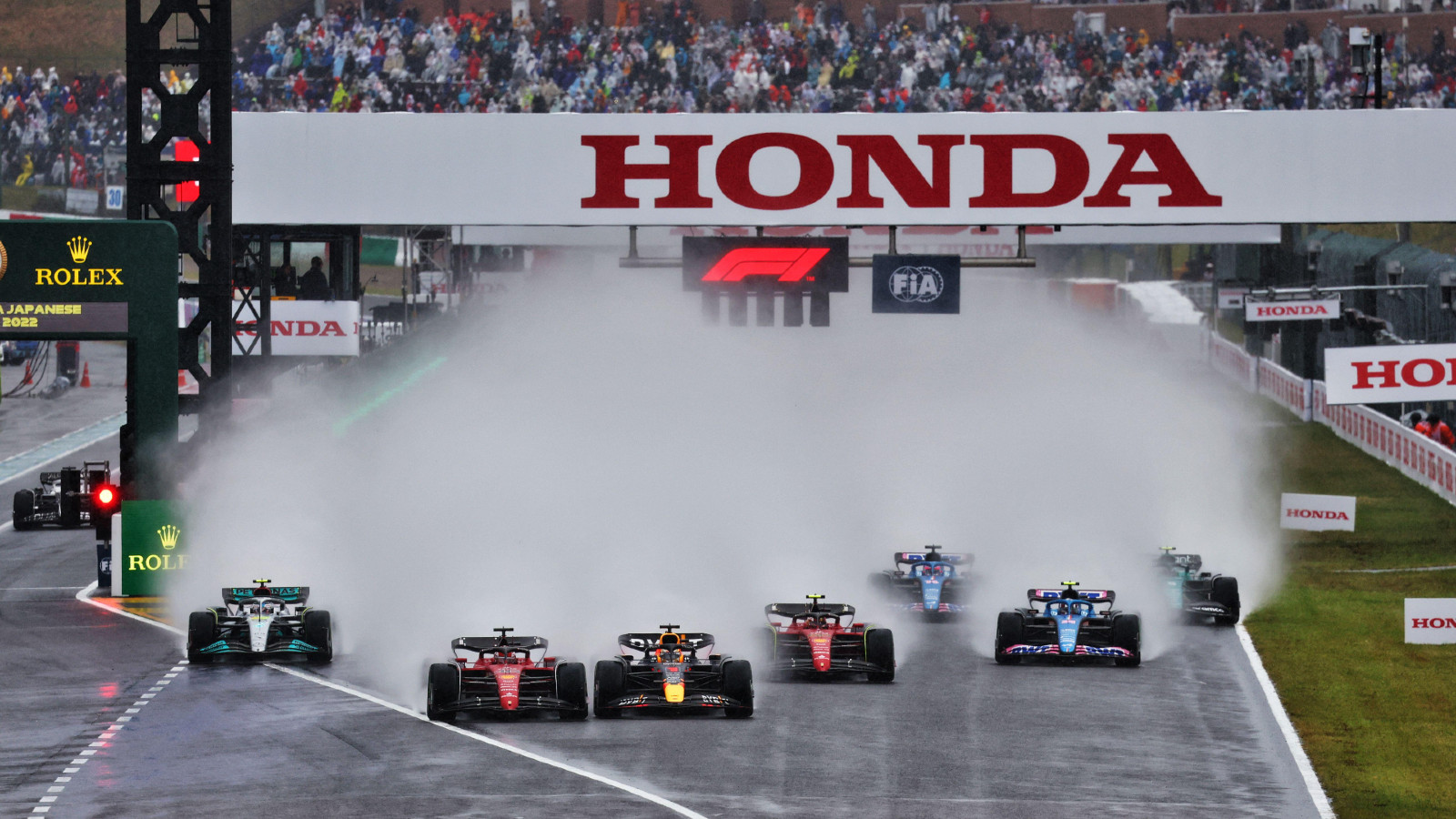Every year, the Formula One circus travels to Japan for one of the most anticipated and thrilling races of the season: the Japanese Grand Prix at the Suzuka circuit. Suzuka is not just a race, it is a legend.
It is a test of skill, courage and passion for both drivers and fans. The Suzuka Circuit is a place that has made history, crowned champions and shattered dreams.
The Suzuka circuit is a circuit like no other. It is a masterpiece of design, a rollercoaster of speed and adrenaline. It has everything a driver could ask for: fast corners, slow corners, elevation changes, overtaking opportunities and technical challenges.
F1worldwide.com Recommends
- Navigating the Suzuka Circuit – A Corner-By-Corner Insight
- Yuki Tsunoda: The Japanese F1 Driver Making Waves
- Yuki Tsunoda as a Child
- Yuki Tsunoda Drives His Dream Cars: A Honda NSX and a Civic Type R
Suzuka circuit is also a festival of culture and hospitality. It is a chance to experience the beauty and diversity of Japan, its people and its traditions. Enjoy the delicious cuisine, the vibrant nightlife and the warm welcome of the locals. It is a chance to immerse yourself in the atmosphere and excitement of one of the most passionate and loyal fan bases in the world. Suzuka is more than just a race.
It is an adventure, an experience, a spectacle, a journey that will leave you breathless, exhilarated and hungry for more. It is a journey that you will never forget.
Index To Article On The Japanese Grand Prix 2023
Index To This Article
- When Is The Japanese F1?
- The History Of The Japanese GP
- Which F1 Teams Will Be In The-Japanese GP 2023
- The Suzuka Circuit – What To Expect
- Where To Watch The Japanese GP 2023
- How to Buy Japanese GP 2023 Tickets
- How To Get To The Japanese GP
- Other Activities To Enjoy At Suzuka
Japanese Grand Prix 2023 Date – When Is The Japanese F1?
| 24 September |
| Race |
| 14:00 |
| 23 September |
| Qualifying |
| 15:00 – 16:00 |
| 23 September |
| Practice 3 |
| 11:30 – 12:30 |
| 22 September |
| Practice 2 |
| 15:00 – 16:30 |
| 22 September |
| Practice 1 |
| 11:30 – 12:30 |
The History of the Japanese Grand Prix
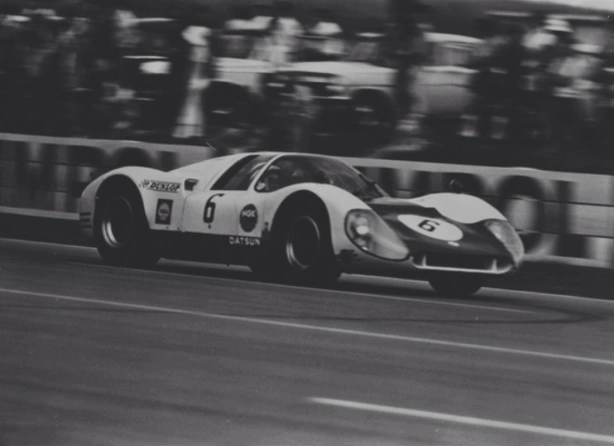
The Japanese Grand Prix is one of the most prestigious and exciting races in the Formula One calendar. It has a rich history that spans over six decades and has witnessed many memorable moments and thrilling battles for the world championship.
The first Japanese Grand Prix was held in 1963 as a sports car race at the Suzuka Circuit, which was owned by Honda. The race was dominated by foreign cars and drivers, but it marked the beginning of motor racing in Japan.
The race was held annually at the Suzuka circuit until 1969, except for 1965 when it was cancelled. Nissan won the race three times in the following years.
| Year | Car Model |
|---|---|
| 1966 | R380 |
| 1968 | R381 |
| 1969 | R382 |
The first Japanese F1 Grand Prix was held in 1976 at the Fuji Speedway, which was owned by Toyota.
Japanese Grand Prix – James Hunt And Nikki Lauda
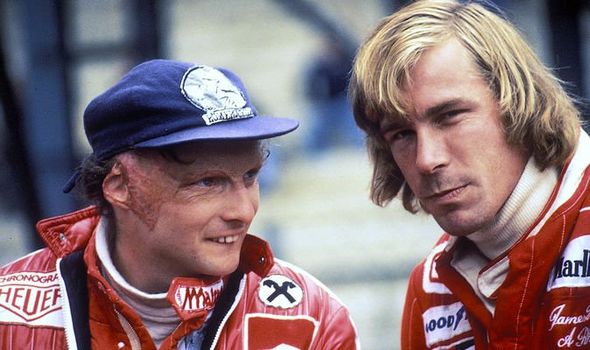
The race was a dramatic title decider between James Hunt and Niki Lauda. The story has become something of a legend. At that stage of the championship only three points separated the two drivers.
The weather conditions on the day of the were wet and foggy at the Suzuka circuit. Lauda chose to retire after two laps, citing safety concerns with the poor viz and wet track surface.
Hunt continued and finished third. It was enough to secure his first and only world championship by one point.
Sadly There Were Also Some Terrible Accidents
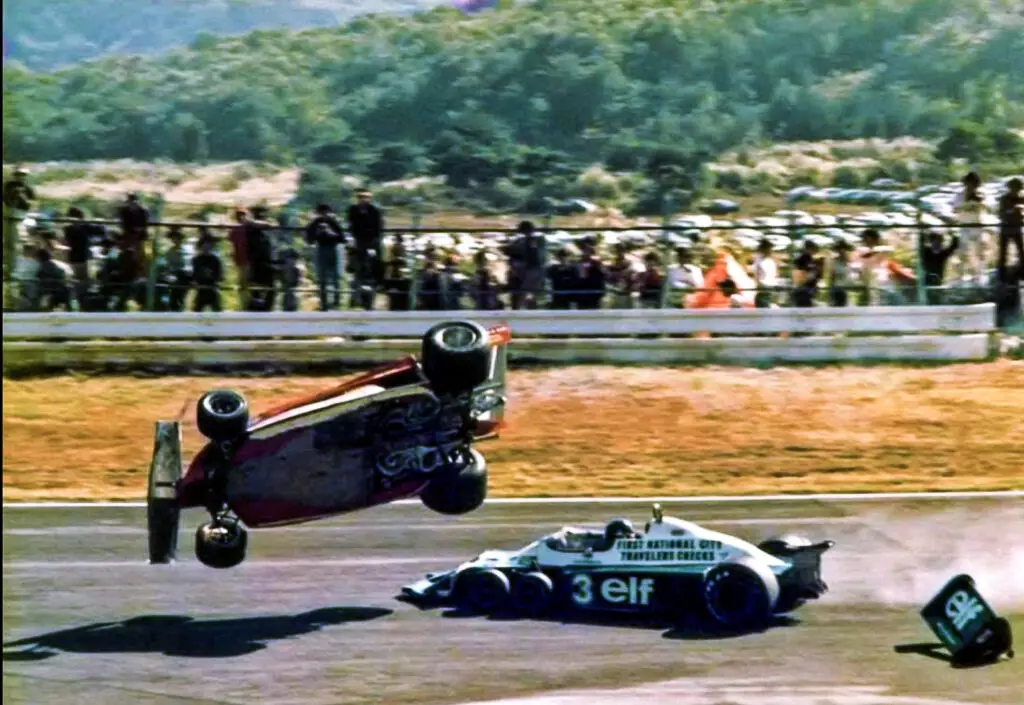
The race returned to Fuji in 1977, but it was marred by a fatal accident involving Gilles Villeneuve and Ronnie Peterson.
The race was then taken off the calendar until 1987, when it moved back to the Suzuka circuit. The circuit became a favorite among drivers and fans for its challenging layout and fast corners.
The Senna / Prost Rivalry Was Epic
It also hosted many title-deciding races, such as the famous duels between Ayrton Senna and Alain Prost in 1988, 1989 and 1990.
In 1994 and 1995, Japan also hosted the Pacific Grand Prix at the TI Circuit in Aida. This made it one of the few countries to host two races in the same season (Ed – there are three races in America in 2023!).
The Pacific Grand Prix was won by Michael Schumacher both times.
From 1996 to 2006, the Japanese Grand Prix was held exclusively at Suzuka, where Schumacher won six times and clinched three of his seven world titles.
In 2007 and 2008, the race moved back to Fuji, where Lewis Hamilton and Fernando Alonso won respectively.
In 2009, the race returned to Suzuka, as part of an alternating agreement between Toyota and Honda. Toyota withdrew from hosting the race after 2008 due to the global financial crisis.
This left Suzuka as the sole venue for the Japanese Grand Prix since then. Suzuka has witnessed many memorable races in recent years, such as
- Sebastian Vettel’s four consecutive wins from 2009 to 2012
- Jules Bianchi’s tragic crash in 2014
- Lewis Hamilton maiden pole position at Suzuka on 2017.
- Max Verstappen’s maiden pole position in 2019 and his dominant victory in 2022.
The Japanese Grand Prix is scheduled to remain at Suzuka until at least 2024. It is one of the most popular and respected races among drivers and fans alike, and a true test of skill and speed for the Formula One world championship.
Which F1 Teams Will be in The Japanese Grand Prix 2023?
All ten of the F1 teams will be present in Japanese GP. Everyone expects Max Verstappen to continue his dominance during the event at the Suzuka circuit.
Most teams have already waved the white flag at Red Bull and now are concentrating on the race that really matters to them. That means they are concentrating on their pier teams that have similar results.
This means that the newly fired up Mercedes F1 team is focusing on competing with Aston Martin and Ferrari.
Although after a series of own goals in 2023 Ferrari is beginning to look like it belongs at the middle of the pack.
Behind them we are seeing a fantastic battle developing between Alpine, McLaren and Alpha Tauri (possible Alfa Romeo as well).
After the race In Canada there seems to be some life from Alex Albon and The Williams Team (time will tell.)
And then there is Haas who is the weakest team so far this year.
The Suzuka Circuit – What to Expect
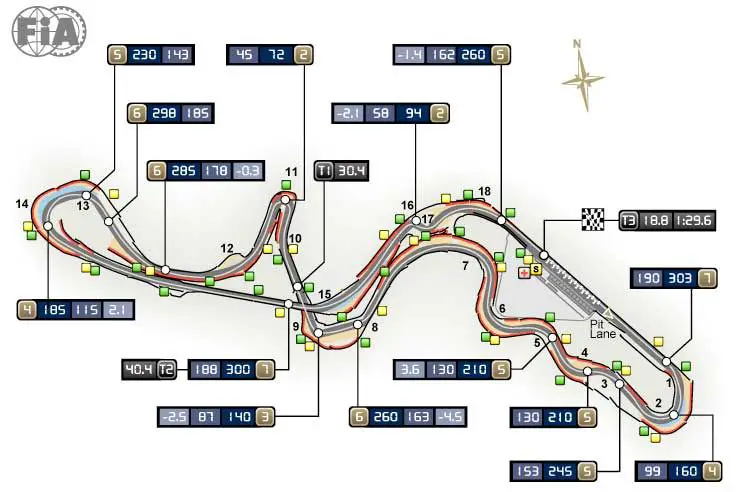
Suzuka is one of the most iconic and challenging circuits in Formula One, with a unique figure-of-eight layout that features a variety of corners and elevation changes .It rewards the drivers who can master its variety and difficulty.
But it demands respect and skill, and a circuit that provides excitement and drama. Every driver wants to win the iconic Japanese GP, and it is a circuit that every fan loves to watch.
The circuit is 5.807 km long and has 18 turns, with a lap record of 1:31.540 set by Kimi Räikkönen in 2005.
It is divided into three sectors, each with its own characteristics and challenges.
The Suzuka circuit – Sector 1
The first sector of the The Suzuka circuit – consists of a series of high-speed Esses that test the car’s aerodynamics and the driver’s rhythm.
The lap starts with a short run to the first corner, a tight right-hander that can be taken in third gear at around 140 km/h. The exit is important as it leads to a long straight that reaches over 300 km/h before braking hard for the second corner, a sharp left-hander that can be tricky in the wet.
The second corner is followed by a series of fast Esses that form the most technical part of the circuit. The driver has to balance the throttle and steering inputs to maintain the speed and momentum through the constant changes of direction.
The Suzuka circuit – The Esses
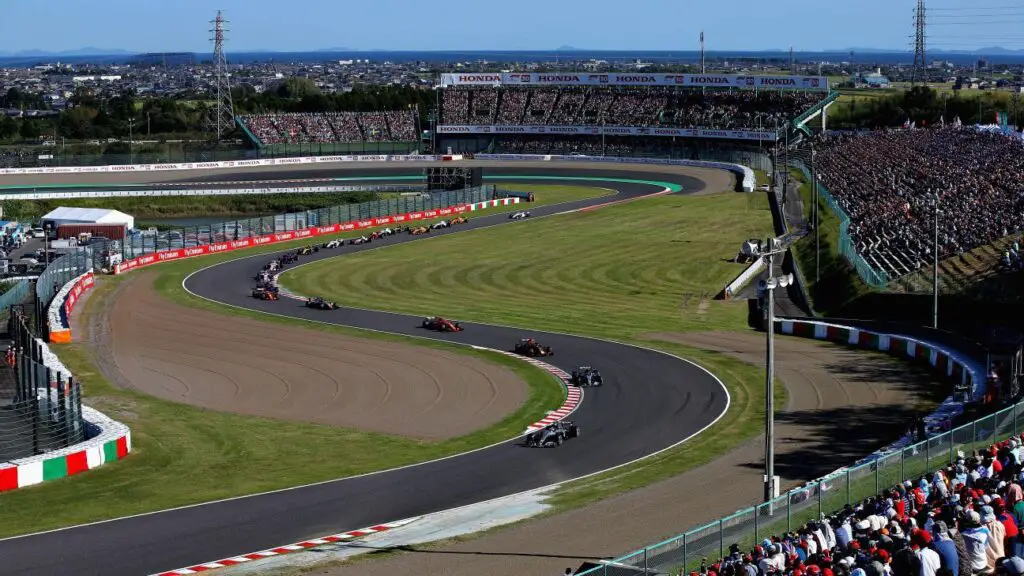
The car has to be stable and responsive, as any mistake can cost valuable time or result in a spin. The Esses start with turn three, a right-hander taken in fifth gear at around 245 km/h, and end with turn seven, a left-hander taken in fourth gear at around 200 km/h.
The Esses lead to two medium-speed corners, turn eight (Dunlop Curve) and turn nine (Degner Curve). F1 drivers take these in third gear at around 150 km/h.
Turn eight is a long left-hander that requires a smooth entry and exit, while turn nine is a tricky right-hander that has a blind apex and a bump on the exit. The drivers have to be careful not to run wide or hit the kerbs too hard.
After turn nine, there is a short straight that leads to turn 10. It is a slow left-hander that drivers take in second gear at around 90 km/h.
A short straight that crosses over the track through an underpass follows this corner. The drivers have to be careful not to lose traction or damage the car on the bumpy surface.
The Suzuka circuit – Sector 2
The second sector of the The Suzuka circuit – includes the famous Spoon Curve and the 130R, which require precision and bravery.
The next corner is turn 11 (Hairpin), a tight right-hander. Drivers have to change down to first gear at around 80 km/h.
This corner is one of the few overtaking opportunities on the circuit. The drivers can slipstream their rivals on the preceding straight and dive into the inside under braking.
The exit is important as it leads to another long straight that reaches over 300 km/h before braking for turn 12 (Spoon Curve).
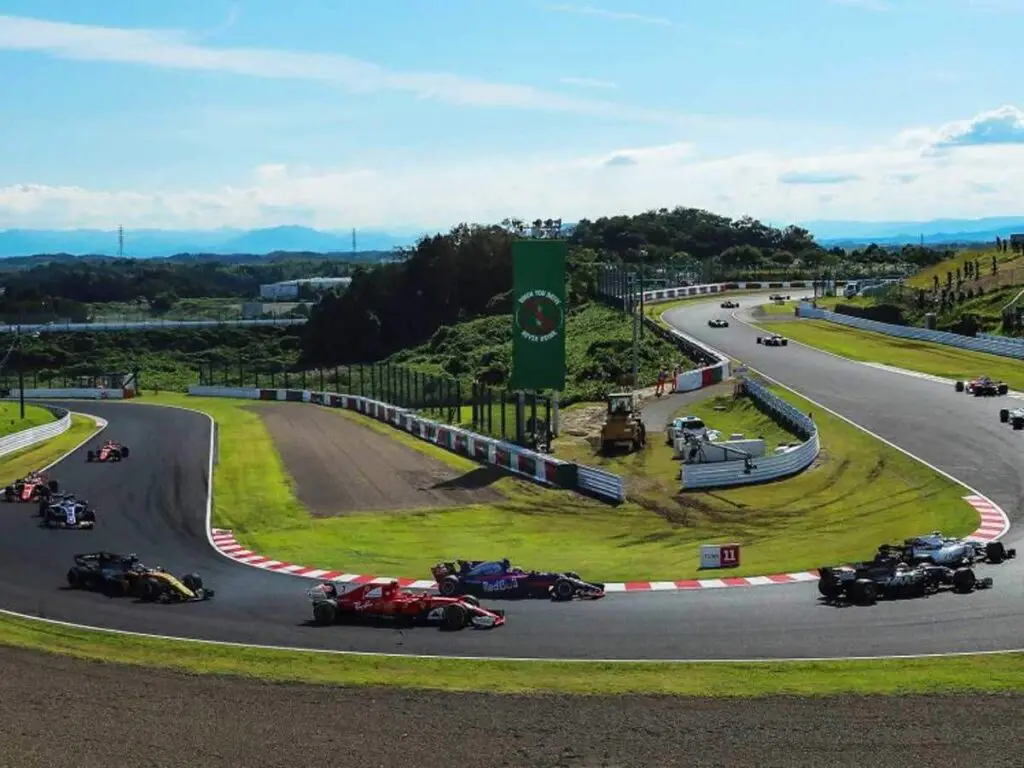
Spoon Curve is one of the most challenging corners on the circuit. It consists of two parts:
- Turn 13, a fast left-hander taken in fourth gear at around 180 km/h.
- Turn 14, a slower left-hander taken in third gear at around 140 km/h.
The drivers have to find the right line and speed through this complex corner, as any mistake can compromise their run onto the next straight. The car has to be well balanced and have good traction out of turn 14.
The next straight is the longest on the circuit, measuring over 1 km in length.
The drivers reach speeds of over 310 km/h before braking for turn 15 (130R), a legendary corner that tests their courage and skill.
130R is a sweeping left-hander. F1 drivers take it flat-out in seventh gear at around 310 km/h, subjecting them to massive g-forces. The drivers have to keep their foot down and steer smoothly through this corner, avoiding any sudden movements or corrections.
The Suzuka circuit – Sector 3
The third sector of the The Suzuka circuit – features a tight chicane and a long pit straight, where braking and traction are crucial.
After 130R, there is another short straight that leads to turn 16 (Casino Triangle). This is a tight chicane that F1 drivers take in second gear at around 90 km/h.
The corner is another overtaking opportunity on the circuit, as the drivers can use their DRS on the preceding straight and brake late into the chicane. The exit is crucial as it leads to the final straight and the start-finish line.
Drivers have to accelerate hard and avoid any wheelspin or oversteer out of the chicane.
The lap ends with a long pit straight that reaches over 300 km/h before braking for turn one again.
Where To Watch the Japanese GP 2023
The Suzuka circuit has a variety of grandstands to suit different preferences and budgets. (Check out this website for F1 spectator experiences)Whether you want to see the start and finish line, the pit lane action, the overtaking opportunities, or the scenic views, there is a grandstand for you. Here are some of the best grandstands to watch the Japanese GP.
Japanese Grand Prix – Grandstand V1 and V2
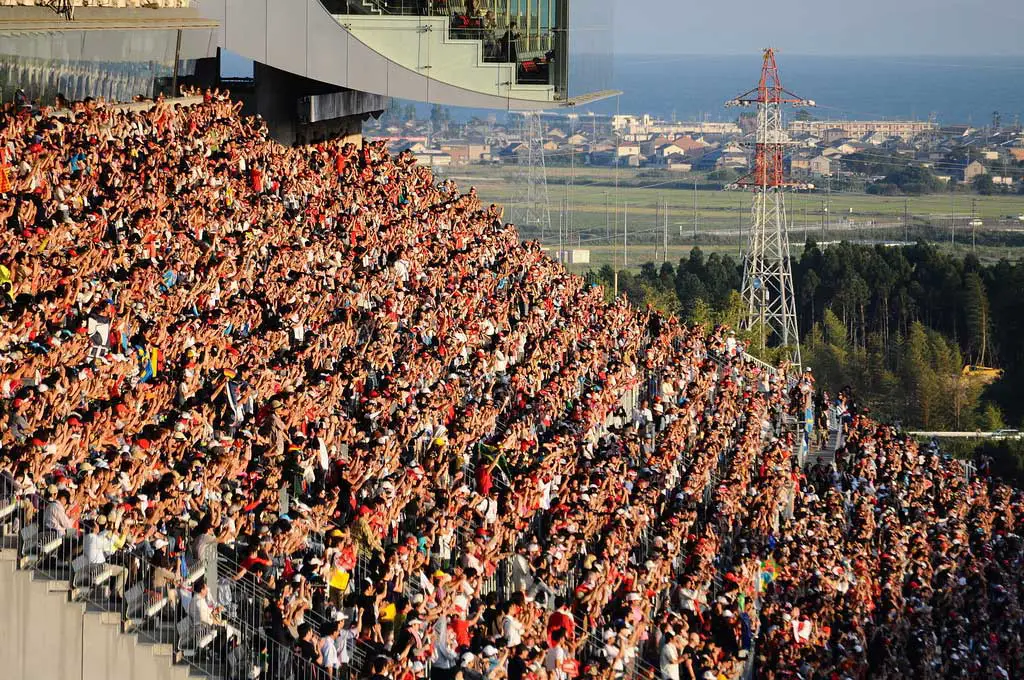
V1 and V2 are the main grandstands that overlook the start-finish straight, the grid and the pit lane. They are in two sections:
- V1 is the lower part of the stand, closer to the track. V1 offers a closer view of the grid and the speed of the cars.
- V2 is the upper part of the stand, higher and covered. V2 offers a better view of the pit stops, the team garages and some distant corners, such as turn one and turn 18.
Both sections have numbered seating and a big screen opposite them.
Japanese Grand Prix – Grandstand A1 and A2
A1 and A2 are similar to V1 and V2, but located further along the straight, closer to turn one. They are in two sections:
- A1 is the lower part of the stand. A1 offers a closer view of the braking zone for turn one.
- A2 is the upper part of the stand, which is covered. A2 offers a better view of turn one and turn two, which are medium-speed corners where overtaking can happen.
Both sections have numbered seating and a big screen opposite them.
Japanese Grand Prix – Grandstand B1 and B2
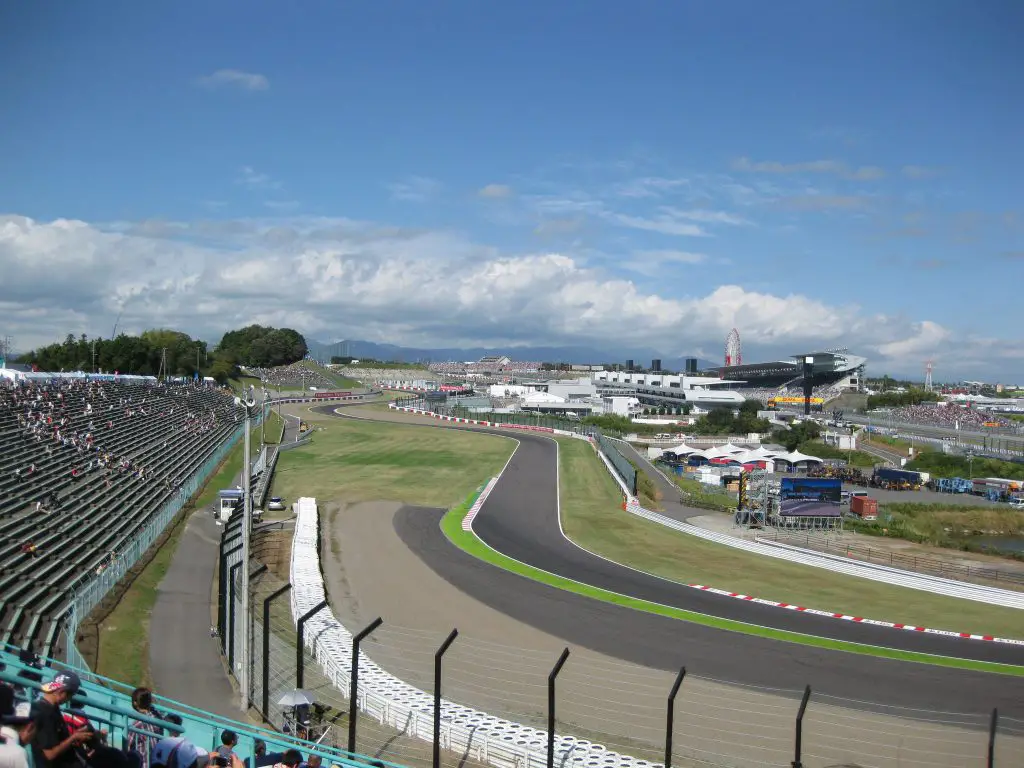
These are also one behind the other, but located at turn one. They offer a great view of the first corner, where the cars have to slow down and turn while avoiding collisions.
B1 is the lower part of the stand, and B2 is the upper part of the stand, which is not covered.
B2 offers a better view of turn two and some distant corners, such as turn seven and turn eight. B1 offers a closer view of turn one and its apex. Both sections have numbered seating and a big screen opposite them.
Japanese Grand Prix – Grandstand C
This is a large grandstand that covers turns two to five, which are part of the fast Esses section. It offers a view of the cars changing direction rapidly at high speed, testing their aerodynamics and balance.
The grandstand is not covered and has numbered seating. There is a big screen opposite it.
Japanese Grand Prix – Grandstand D
This is a small grandstand that covers turn six, which is the last corner of the Esses section. It offers a view of the cars exiting the Esses and entering a short straight that leads to turn seven.
The grandstand is not covered and has numbered seating. There is no big screen opposite it.
Japanese Grand Prix – Grandstand E
This is a small grandstand that covers turn seven, which is a medium-speed left-hander that leads to turn eight (Dunlop Curve).
It offers a view of the cars entering and exiting turn seven, which requires a smooth entry and exit. The grandstand is not covered and has numbered seating. There is no big screen opposite it.
Japanese Grand Prix – Grandstand F
This is a small grandstand that covers turn eight (Dunlop Curve), which is a long left-hander that leads to turn nine (Degner Curve). It offers a view of the cars entering and exiting turn eight, which requires a smooth line and speed.
The grandstand is not covered and has numbered seating. There is no big screen opposite it.
Japanese Grand Prix – Grandstand G
This is a small grandstand that covers turn nine (Degner Curve), which is a tricky right-hander that has a blind apex and a bump on the exit. It offers a view of the cars entering and exiting turn nine, which requires precision and care. The grandstand is not covered and has numbered seating. There is no big screen opposite it.
Japanese GP – Grandstand H
This is a small grandstand that covers turn 10, which is a slow left-hander that leads to an underpass where the track crosses over itself. It offers a view of the cars entering and exiting turn 10, which requires good braking and traction.
Japanese Grand Prix – Grandstand I
This is a small grandstand that covers turn 11 (Hairpin), which is a tight right-hander that leads to a long straight. It offers a view of the cars entering and exiting turn 11, which requires good braking and overtaking skills.
The grandstand is not covered and has numbered seating. There is no big screen opposite it.
Japanese Grand Prix – Grandstand J
This is a large grandstand that covers turns 12 to 14 (Spoon Curve), which is a challenging two-part corner that leads to another long straight. It offers a view of the cars entering and exiting Spoon Curve, which requires the right line and speed.
The grandstand is not covered and has numbered seating. There is a big screen opposite it.
Japanese Grand Prix – Grandstand K
This is a small grandstand that covers turn 15 (130R), which is a legendary corner that can be taken flat-out at over 300 km/h. It offers a view of the cars entering and exiting 130R, which requires courage and skill.
The grandstand is not covered and has numbered seating.
There is no big screen opposite it.
Japanese Grand Prix – Grandstand L
This is a small grandstand that covers turn 16 (Casino Triangle), which is a tight chicane that leads to the final straight. It offers a view of the cars entering and exiting Casino Triangle, which requires good braking and traction.
The grandstand is not covered and has numbered seating. There is no big screen opposite it.
Japanese Grand Prix – Grandstand M
This is a small grandstand that covers the final straight, before the start-finish line. It offers a view of the cars accelerating hard and crossing the line, as well as the podium ceremony. The grandstand is not covered and has numbered seating.
There is no big screen opposite it.
Japanese Grand Prix – Grandstand Q1
Seats in Q2 stand come highly recommended and are about the most popular at Suzuka. Seats to the left (block 1) of the grandstand offer the best views of the last corner and pitlane entrance and to the right of the stand (block 3) your view extends as far as the legendary 130-R
How to Buy Japanese GP 2023 Tickets
The Japanese GP tickets are sold. Keep this in mind to try again for 2024.
How To Get to the Japanese GP
The Japanese Grand Prix is one of the most exciting and popular races in the Formula One calendar. It is held at the Suzuka Circuit, a legendary track that features challenging corners, fast straights and a unique figure-eight layout.
The race attracts thousands of fans from all over the world, who come to witness the thrilling action and enjoy the rich culture and hospitality of Japan.
If you are planning to attend the Japanese GP, here are some tips on how to get there and make the most of your trip.
Getting to Japan
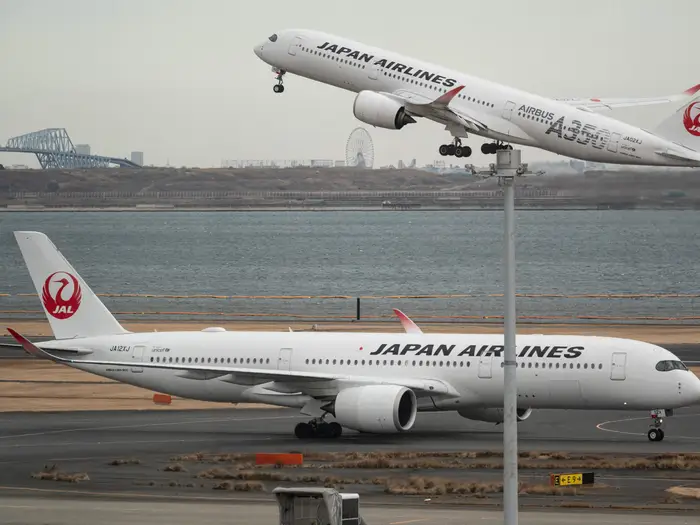
The easiest way to get to Japan is by flying to one of its major international airports, such as Tokyo Narita, Tokyo Haneda, Osaka Kansai or Nagoya Chubu. Depending on where you are coming from, you may need to book a connecting flight or a stopover in another country.
You can find and compare flights using online travel platforms such as Skyscanner, Expedia or Kayak. You can also check the official websites of airlines that fly to Japan, such as Japan Airlines, ANA, Delta, United or British Airways.
Getting to the Suzuka Circuit
Once you arrive in Japan, you will need to travel to Suzuka, which is located in the Mie Prefecture, about 300 km southwest of Tokyo and 100 km southeast of Osaka.
There are several options to get there by public transport or by car.
Get to the Suzuka Circuit By Train

The fastest and most convenient way to get to the Suzuka circuit by train is by taking the Shinkansen (bullet train) from Tokyo or Osaka to Nagoya. You can then transfer to a local train to Suzuka Circuit Ino Station.
The Shinkansen takes about 1.5 hours from Tokyo and 50 minutes from Osaka to Nagoya. Tickets cost around 11,000 yen ($100) and 6,000 yen ($55) respectively for a one-way ticket.
You can buy your tickets at the station or online using platforms such as JR East or SmartEX.
From Nagoya, you can take the Kintetsu Limited Express train to Suzuka Circuit Ino Station. It takes about 40 minutes and costs around 1,500 yen ($14) for a one-way ticket.
You can buy your tickets at the station or online using platforms such as Kintetsu Railway or Eki-net.
Alternatively, you can take the JR Rapid Mie train from Nagoya to Shiroko Station, which takes about an hour and costs around 1,000 yen (9 USD) for a one-way ticket. Tickets are available at the station or online using platforms such as JR Central or SmartEX.
From Suzuka Circuit Ino Station or Shiroko Station, you can take a free shuttle bus to the circuit, which runs every 15 minutes during the race weekend. The bus ride takes about 15 minutes.
Get to the Suzuka Circuit By Bus
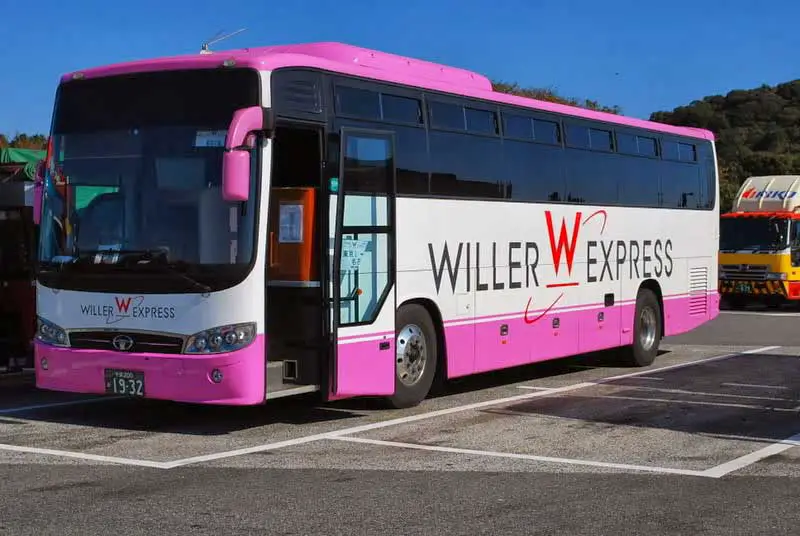
Another option to get to the Suzuka circuit by bus is by taking the Willer Express highway bus from Tokyo or Osaka to Yokkaichi Station.
The bus takes about 7 hours from Tokyo and 4 hours from Osaka to Yokkaichi. Tickets cost around 4,000 yen ($36) and 3,000 yen ($27) respectively for a one-way ticket.
Tickets are available online using platforms such as Willer Express or Bus Online Ticket.
From Yokkaichi Station, you can take a local bus to Suzuka Circuit East Gate, which takes about 40 minutes and costs around 500 yen ($5) for a one-way ticket. You can buy your tickets at the station or on board the bus.
Get to the Suzuka Circuit By Car
If you prefer to drive to the Suzuka circuit by car, you will need to rent a car from one of the major rental companies in Japan. The most well kown rental agencies are
You will also need an international driving permit and a valid driver’s license from your home country.
The drive from Tokyo or Osaka to Suzuka takes about 5 hours and covers around 400 km.
You will need to pay toll fees along the way, which amount to around 10,000 yen ($90) and 6,000 yen ($55) respectively for a one-way trip. You can use online tools such as NaviTime or Google Maps to plan your route and check traffic conditions.
There are several parking areas near the circuit, which charge around 2,000 yen ($18) per day. You will need to book your parking spot in advance online using platforms such as Park24 or Times Car Plus.
Getting Around the Suzuka Circuit
Once you get to Suzuka, you can explore the circuit and its surroundings by foot, by bike or by bus.
Getting Around the Suzuka Circuit by Foot
You can walk around the circuit and enjoy the sights and sounds of the race weekend.
However, walking can be tiring and time-consuming, especially if you want to visit different grandstands or areas of the circuit. You may also need to cross some busy roads or bridges, which can be dangerous.
Because of this, walking is not recommended.
Getting Around the Suzuka Circuit by Bike
A more convenient and fun way to get around Suzuka is by bike. You can rent a bike from one of the rental stations near the circuit, such as the Suzuka Circuit Bike Rental or the Suzuka Circuit Rental Cycle.
The rental fee is around 1,000 yen ($9) per day, and you will need to show your passport or driver’s license as identification.

Designated bike lanes and paths around installed around the circuit and are marked with signs and arrows.
You can also park your bike at any of the bike parking areas near the grandstands or facilities. Riding a bike is a great way to explore the circuit at your own pace and enjoy the scenery and atmosphere of Suzuka.
Getting Around the Suzuka Circuit by Bus
Another option to get around Suzuka is by bus.
Getting Around the Suzuka Circuit by Free Shuttle Bus
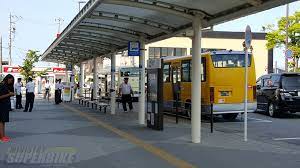
You can take the free shuttle bus that runs between Suzuka Circuit Ino Station, Shiroko Station and the circuit.
The bus operates every 15 minutes during the race weekend and stops at various points around the circuit, such as the Main Gate, the East Gate, the West Gate and the Paddock Gate.
Getting Around the Suzuka Circuit by Paid Shuttle Bus
can also take the paid shuttle bus that runs between Yokkaichi Station and the circuit. The bus operates every 30 minutes during the race weekend and costs around 500 yen ($5) for a one-way ticket.
You can buy your tickets at Yokkaichi Station or on board the bus.
The bus is a convenient and comfortable way to get to and from the circuit, especially if you are carrying luggage or have mobility issues.
However, the bus can be crowded and slow during peak hours, so you may need to wait in line or allow extra time for your journey.
Enjoying The Race At The Japanese GP
Finally, you are ready to enjoy the race. Here are some tips to make the most of your experience:
- Arrive early: The gates open at 7:00 am on Friday, Saturday and Sunday. Arrive early to avoid queues and secure a good spot.
- Bring earplugs: The sound of the F1 cars is very loud and can damage your hearing. Bring earplugs or headphones to protect your ears and enjoy the race.
- Dress appropriately: The weather in Suzuka can be unpredictable and change quickly. Dress in layers and bring a raincoat or umbrella in case of rain.
Other Activities To Enjoy At The Suzuka Circuit
The Japanese F1 is not the only attraction that Suzuka has to offer.
The Suzuka Circuit is a large complex that spans over 5.8 km and has several facilities and attractions. Some of these are listed below.
- The Motopia amusement park
- The Racing Theater Museum
- The Hotel Xanadu and the Suzuka Circuit Hotel.
Suzuka Forest Garden
The Suzuka Forest garden is a research and cultivation farm that enables the Japanese traditional cultivation skills to be handed on to future generations.
Suzuka Forest Garden features a collection of precious weeping Japanese plum trees. Many of them are Kureha Shidare and some are classified in the largest class in Japan.


